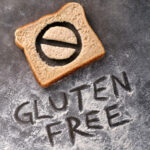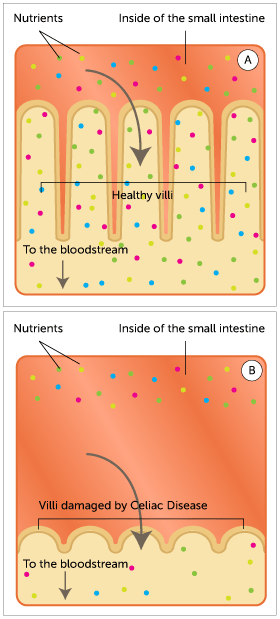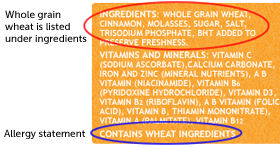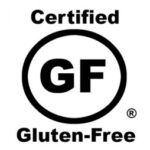Gluten-Free Diet for Parents: General Information

You may have heard about the gluten free diet on TV or read about it in a magazine or online. Despite what some people may think, the gluten–free diet is not a weight loss diet. The gluten–free diet is a recommended by a health care provider for people who have either been diagnosed with celiac disease, an autoimmune disorder that’s triggered by gluten, or with non-celiac gluten sensitivity. If your teen has been diagnosed with celiac disease, she must follow a gluten–free diet to heal her body and reduce signs and symptoms of celiac disease. This guide was created for you and your family to help navigate the gluten–free diet including how to avoid gluten, how to identify gluten–free foods, and how to adapt to a gluten–free lifestyle.
What is gluten?
Gluten is a protein complex found in the grains wheat, barley, and rye. Flours made from these grains are commonly used to make foods such as breads, cereals, pasta, pizza, and baked goods. The gluten gives these foods an elastic texture and helps provide the structure.
Why would someone need to follow a gluten–free diet?
Anyone with celiac disease should follow a strict gluten–free diet to avoid causing long term damage to the small intestine (see image) as well as symptoms. If your teen’s health care provider tells her that she has gluten sensitivity she should also follow a gluten-free diet in order to avoid any symptoms she may have.

What is celiac disease?
Celiac disease is an autoimmune disorder that is triggered when gluten–containing foods are eaten. An autoimmune disorder is one in which the body’s immune system attacks an organ. When a person with celiac disease eats a food with gluten in it, the immune system launches an attack against the small intestine which damages the lining of the intestine and decreases nutrient absorption. Noticeable symptoms of celiac disease include diarrhea, abdominal pain, weight loss, nutritional deficiencies, anemia, poor appetite, irregular periods, delayed growth, and delayed onset of puberty. Some teens will have almost no noticeable symptoms, but their health care provider may detect low bone density.
Gluten is harmful for someone with celiac disease. Following a gluten–free diet prevents harm to the small intestine and allows it to heal. The gluten–free diet should eventually stop your teen’s symptoms of celiac disease or gluten intolerance.
What is gluten sensitivity?
Gluten sensitivity, also called non-celiac gluten sensitivity or gluten intolerance can be diagnosed if a person does not have celiac disease or a wheat allergy (both of these tests are negative) but they have some similar symptoms and they feel better when they are on a gluten-free diet. While someone with gluten sensitivity will have similar symptoms as a person with celiac disease, they do not have the same intestinal damage. It is unclear whether people with gluten sensitivity need to be as strict about adhering to a gluten-free diet. There is no definitive test for gluten intolerance. If you think that your teen might have celiac disease (or an allergy to wheat or gluten sensitivity), she should consult with a medical professional rather than simply avoiding gluten. A health care provider will want to have testing done while she is still eating gluten in order to give her the best medical care.
Things to keep in mind…
A gluten-free diet isn’t always a healthy diet. Some people who follow a gluten–free diet may not get enough of certain nutrients, vitamins, and minerals in their diet such as fiber, iron and calcium. Also, some gluten–free products can be high in calories and sugar. If your teen must follow a gluten–free diet, it’s best to meet with a dietician to develop a healthy, balanced meal plan and to identify if any vitamin or mineral supplements are necessary. It is not suggested that people follow a gluten-free diet if not medically necessary.
There are many hidden sources of gluten both in food and non-food products. Gluten is also found in foods such as candy, sauces, soups, and marinades. Remember to check products such as toothpaste, mouthwash, lipstick/gloss, stamps/envelope, glues, supplements, vitamins, and both prescription and over the counter medications. These are frequently overlooked sources of gluten. Check with your pharmacist and ask your teen’s health care provider to write, “Medication must be gluten–free” on any prescriptions. Many soaps, shampoos, and lotions contain wheat or oats. While gluten cannot be absorbed through the skin, it is important to be aware of this – especially if your teen has a habit of biting her finger nails or touching food after putting on lotion.

 There is also a symbol that may appear on packaging of gluten-free foods, which the Gluten Intolerance Group has deemed “Certified Gluten Free.” This symbol represents that the food manufacturer has applied for and been granted certification of the product’s status of gluten-free, by submitting test results showing that there is no gluten contained in the product.
There is also a symbol that may appear on packaging of gluten-free foods, which the Gluten Intolerance Group has deemed “Certified Gluten Free.” This symbol represents that the food manufacturer has applied for and been granted certification of the product’s status of gluten-free, by submitting test results showing that there is no gluten contained in the product.